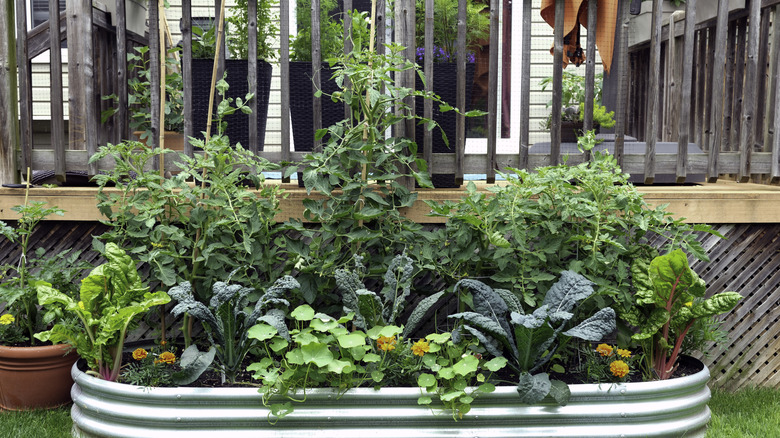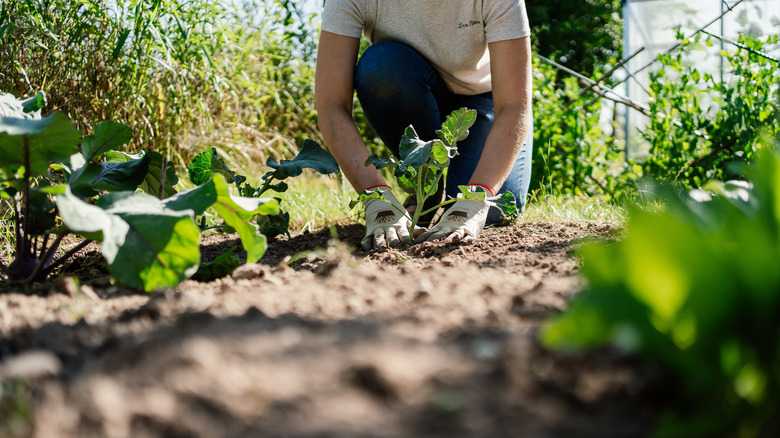The Low-Effort Gardening Method That Is Best For Preventing Weeds
No matter how established your garden is or how diligent you are about regularly pulling weeds from your garden beds, it seems like you can never quite eradicate these tenacious yet unwanted plants. If you're tired of trying every new hack to get rid of weeds in your garden, the good news is that one of the most effective methods is also one of the easiest — stop them from growing in the first place. While that sounds like it's easier said than done, prevention is key to effective weed removal because every plant that doesn't germinate is one less plant that can spread its seeds or rhizomes.
One of the best (and easiest) methods of weed prevention is planting in a way that leaves little room and resources for these plants to germinate and grow. Using a low-effort gardening method described by Gardenary in a TikTok video, you can dramatically cut down on the number of weeds you're fighting throughout the growing season without creating much extra work for yourself.
The method, dubbed the "working with nature" approach by Gardenary, involves planting a mix of differently sized species together rather than isolating each species in its own bed. The content creator's claim that taking this extra step to design a mixed planting at the start of the season will cut down on weeding later on is backed up by science. Here's why it works and how to get the best results in your garden.
Why the working with nature method prevents weeds
In the video, the content creator explains that she aims to grow a mix of different-sized species when she maps out and spaces garden veggie plants. Also called intercropping, this method of planting several species in the same bed helps prevent weeds by filling in more of the empty space so there's less room for weeds to grow. It also helps shade the soil to prevent new seeds from sprouting.
One meta-analysis published in Agriculture, Ecosystems and Environment (via Tulane University Libraries) looked at multiple studies on the weed suppressing effects of intercropping. Overall, it found that intercropped beds had 58% fewer weeds than single-crop beds. However, not all intercropping methods the researchers looked at were equally effective. The keys to success seemed to be pairing plants in a way that increased overall plant density and quickly shaded the ground early in the growing season, so that any weed seedlings had less opportunity to grow before getting crowded out.
You'll get the best weed suppression results by adding to your garden bed rather than replacing plants in it. For example, if your bed has room for five plants of the same species based on traditional spacing recommendations, don't swap out one or two of them for a companion. Keep all five, and add a companion species in the space between them. Similarly, the study found that arranging plants randomly rather than in even rows led to the best weed suppression results. This approach helps break up any empty space that remains rather than having long strips of bare soil between rows.
Designing a garden bed that denies weeds a chance to sprout
If you want to try an intercropping method like the one Gardenary shows in the TikTok video, the first step is to decide which species should be planted together. The most important things to consider when selecting suitable companions are days to maturity and roots. For example, fast-growing plants like lettuce or other leafy greens can be planted alongside slower-to-mature veggies like cucumbers. The greens will quickly fill in the empty space between cucumbers and be ready to harvest by the time the slower plants are big enough to need that extra space. When thinking about roots, you typically want to pair deep-rooted plants like carrots or potatoes with shallow-rooted companions like tomatoes. That way, you can plant them closely without them competing for space or nutrients in the soil.
If you're only planting a couple of veggies with similar roots or growth rates, you can use what's known as a living mulch instead to get a similar effect. These are small, non-crop plants that can quickly fill in the empty space but won't compete with your veggies for nutrients. Popular choices include various types of clover, especially white clover (Trifolium repens) because these not only grow quickly but also fix nitrogen in the soil to give your veggies a nutrient boost.
Once you've got your species mix picked out, plant them randomly rather than in perfect rows. Plants of the same species should be spaced according to recommendations. That said, their companions can be snuck in between them to fill in that empty space.


